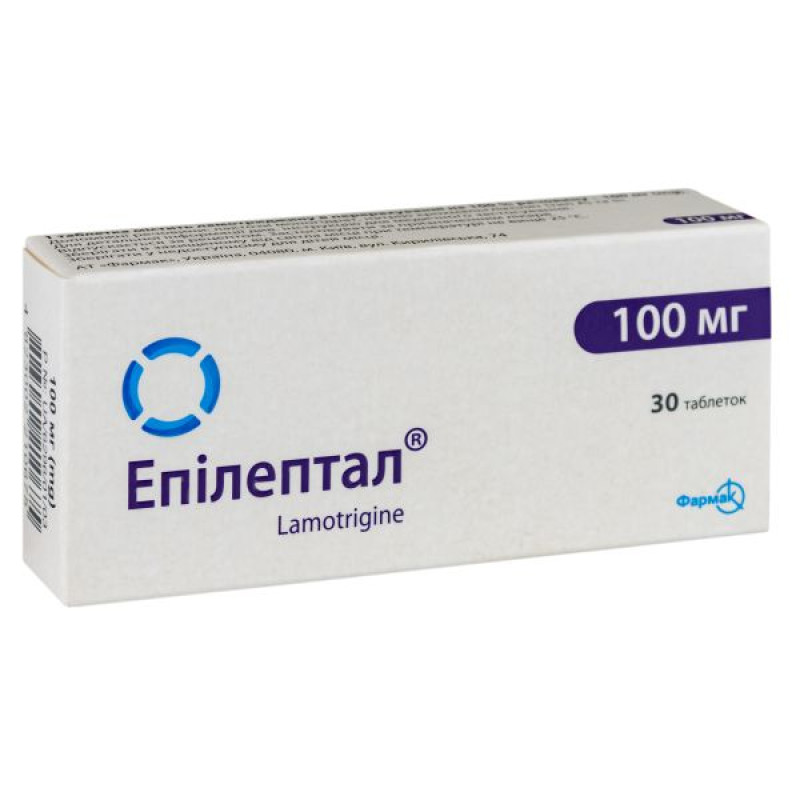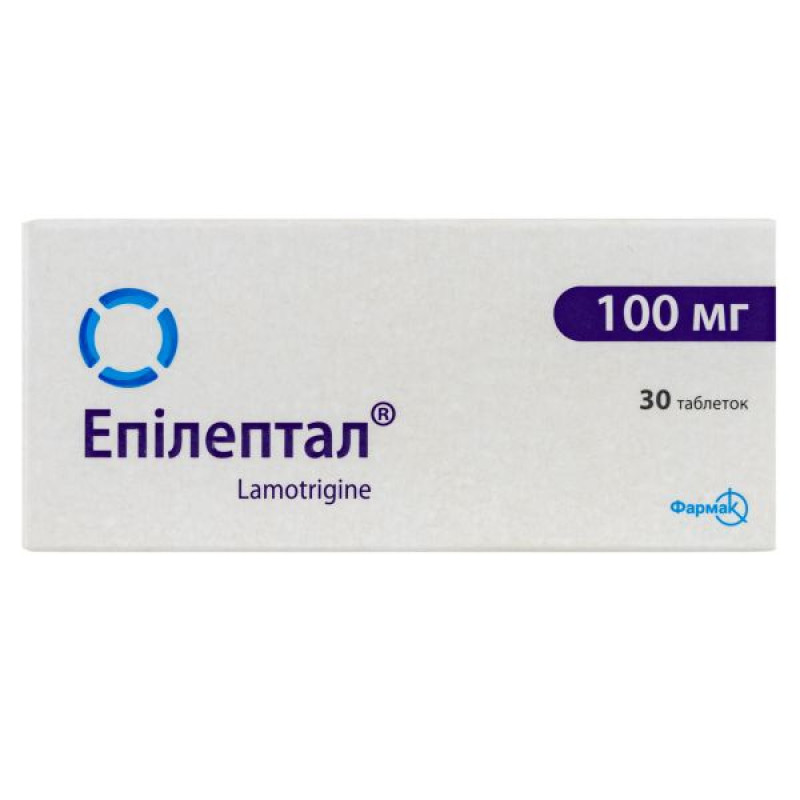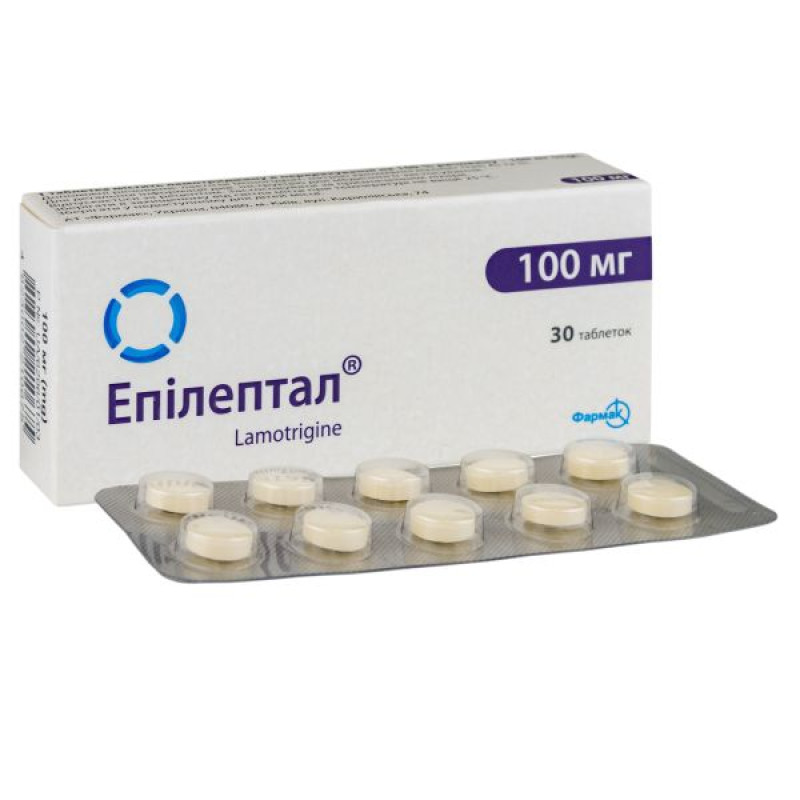Epileptal tablets 100 mg blister No. 30

Epileptal tablets are used for the indications listed below.
epilepsy:
adults and children from 12 years of age: monotherapy and adjunctive therapy of epilepsy, in particular partial and generalized seizures, including tonic-clonic seizures, as well as seizures associated with Lennox-Gastaut syndrome; children from 2 to 12 years of age: adjunctive therapy of epilepsy, in particular partial and generalized seizures, including tonic-clonic seizures, as well as seizures associated with Lennox-Gastaut syndrome (after achieving seizure control, the use of adjunctive drugs can be discontinued and monotherapy with Epileptal can be continued); monotherapy of typical absences;Bipolar disorder (adults): for the prevention of phases of emotional disturbances in patients with bipolar disorder, mainly by preventing depressive episodes.
Composition
The active substance is lamotrigine (one tablet contains 100 mg of lamotrigine in terms of 100% substance).
Excipients: lactose monohydrate, microcrystalline cellulose, sodium starch glycolate (type A), povidone, yellow iron oxide (E 172), magnesium stearate.
Contraindication
Epileptal is contraindicated in patients with known hypersensitivity to lamotrigine or any other component of the drug.
Method of application
"Epileptal" tablets should be swallowed without chewing or breaking.
If the prescribed dose of Epileptal, for example, for use in children (epilepsy only) or patients with impaired liver function, does not correspond to the amount of active substance in whole tablets, it is necessary to prescribe a dose that corresponds to a smaller number of whole tablets.
Restarting treatment
When a patient who has discontinued treatment is re-initiated, the need for an increase in the maintenance dose should be clearly established, as there is a risk of rash due to the high initial dose and exceeding the recommended dose escalation schedule for lamotrigine. The longer the interval between the previous dose, the more careful the dose escalation to the maintenance dose should be. When the interval since discontinuation of lamotrigine has exceeded 5 times the half-life, the lamotrigine dose should be increased to the maintenance dose according to the existing schedule. It is not recommended to restart lamotrigine if treatment was discontinued due to rash associated with previous treatment with lamotrigine. In such cases, the decision to re-initiate the drug should weigh the expected benefits of treatment against the possible risks.
Epilepsy (as monotherapy)
Adults and children from 12 years of age. The initial dose of the drug "Epileptal" is 25 mg 1 time per day for 2 weeks, then take 50 mg / day for the next 2 weeks, then increase the dose by 50-100 mg every 1-2 weeks until the optimal effect is achieved. The usual maintenance dose is 100-200 mg / day in 1-2 doses. Some patients may require a dose of 500 mg / day.
Children aged 2 to 12 years. The initial dose of the drug "Epileptal" for the treatment of typical absence seizures is 0.3 mg / kg / body weight / day in 1-2 doses per day for 2 weeks, then take 0.6 mg / kg / body weight / day in 1-2 doses per day for the next 2 weeks. In the future, the dose should be increased by 0.6 mg / kg every 1-2 weeks until the optimal effect is achieved. The usual maintenance dose is 1-10 mg / kg / day in 1-2 doses. Some patients may require a large dose.
Due to the risk of rashes, the initial dose and the rate of subsequent dose increases should not be exceeded.
Epilepsy (in combination therapy), adults and children from 12 years of age
For patients taking valproate (alone or with other antiepileptic drugs), the initial dose of Epileptal is 25 mg every other day for 2 weeks, then 25 mg daily for the next 2 weeks. After that, the dose should be increased (maximum by 25-50 mg/day) every 1-2 weeks until the optimal therapeutic effect is achieved. The usual maintenance dose is 100-200 mg/day in 1-2 doses.
For patients taking other antiepileptic drugs or other drugs that induce lamotrigine glucuronidation in combination with or without other antiepileptic drugs (except sodium valproate), the initial dose of Epileptal is 50 mg once daily for 2 weeks, then 100 mg/day in 2 divided doses for 2 weeks. Then the dose should be increased (maximum by 100 mg) every 1-2 weeks until the optimal therapeutic effect is achieved. The usual maintenance dose is 200-400 mg/day in 2 divided doses. Some patients may require a dose of 700 mg/day.
For patients taking other drugs that do not significantly induce or inhibit lamotrigine glucuronidation, the initial dose of Epileptal is 25 mg once daily for 2 weeks, followed by 50 mg once daily for the next 2 weeks. After that, the dose should be increased (maximum by 50-100 mg/day) every 1-2 weeks until the optimal therapeutic effect is achieved. The usual maintenance dose is 100-200 mg/day in 1-2 divided doses.
For patients taking antiepileptic drugs with unknown interactions with lamotrigine, the same treatment regimen as for patients taking lamotrigine with valproate is recommended.
Epilepsy (in combination therapy), children from 2 to 12 years of age
For children receiving sodium valproate in combination with or without other antiepileptic drugs, the initial dose of the drug "Epileptal" is 0.15 mg/kg body weight per day in 1 dose for 2 weeks, then - 0.3 mg/kg body weight per day in 1 dose for the next 2 weeks. Then the dose should be increased (maximum by 0.3 mg/kg body weight) every 1-2 weeks until the optimal therapeutic effect is achieved. The maintenance dose is 1-5 mg/kg body weight in 1-2 doses (maximum - 200 mg/day).
For children taking other antiepileptic drugs or other drugs that induce lamotrigine glucuronidation in combination with or without other antiepileptic drugs (except sodium valproate), the initial dose of Epileptal is 0.6 mg/kg body weight per day in 2 divided doses for 2 weeks, then 1.2 mg/kg body weight per day for the next 2 weeks. The dose should then be increased (maximum by 1.2 mg/kg body weight) every 1-2 weeks until the optimal therapeutic effect is achieved. The average maintenance dose is 5-15 mg/kg body weight per day in 2 divided doses (maximum 400 mg/day).
For children taking other drugs that do not significantly induce or inhibit lamotrigine glucuronidation, the initial dose of Epileptal is 0.3 mg/kg body weight per day in 1-2 divided doses for 2 weeks, then 0.6 mg/kg body weight per day in 1-2 divided doses for the next 2 weeks. After that, the dose should be increased (maximum by 0.6 mg/kg) every 1-2 weeks until the optimal therapeutic effect is achieved. The usual maintenance dose is 1-10 mg/kg per day in 1-2 divided doses. The maximum dose is 200 mg/day.
To correctly calculate the maintenance dose, it is necessary to monitor the child's body weight.
For children taking antiepileptic drugs with unknown interactions with lamotrigine, it is recommended that the same treatment regimen be used as for patients taking lamotrigine with valproate.
Due to the risk of rashes, the initial dose and the rate of subsequent dose increases should not be exceeded.
It should be borne in mind that in the absence of Epileptal tablets in a dose of 2 mg, it is impossible to correctly start treatment in children weighing less than 17 kg.
Children under 2 years old
Lamotrigine has not been studied as monotherapy in children under 2 years of age or as adjunctive therapy in children under 1 month of age. The efficacy and safety of lamotrigine as adjunctive therapy for partial onset seizures in children 1 month to 2 years of age have not been established. Therefore, the drug is not recommended for use in this age group.
General recommendations for the treatment of epilepsy
When discontinuing concomitant antiepileptic drugs to achieve lamotrigine monotherapy or when additional antiepileptic drugs are prescribed during lamotrigine treatment, the effect that this may have on the pharmacokinetics of lamotrigine should be considered.
Bipolar disorder (adults)
Due to the risk of rashes, the initial dose and the rate of subsequent dose increases should not be exceeded.
"Epileptal" is recommended for use in patients with bipolar disorders with an increased risk of depressive episodes in the future.
The following transition regimen should be followed. This regimen involves increasing the dose of lamotrigine to a maintenance stabilisation dose over a period of 6 weeks, after which other psychotropic and/or antiepileptic medicinal products may be discontinued if clinically appropriate.
The recommended dose escalation schedule for lamotrigine to achieve a maintenance stabilization daily dose in the treatment of adults with bipolar disorder is:
Adjunctive therapy with inhibitors of lamotrigine glucuronidation, such as valproate. The initial dose for patients taking concomitant therapy with an inhibitor of glucuronidation, such as valproate, is 25 mg every other day for 2 weeks, then 25 mg once daily for the next 2 weeks. The dose should be increased to 50 mg/day (in 1-2 divided doses) at week 5. The usual dose to achieve optimal response is 100 mg/day (in 1-2 divided doses). However, the dose may be increased to a maximum of 200 mg/day depending on the clinical response. Adjunctive therapy with inducers of lamotrigine glucuronidation in patients not taking inhibitors, such as valproate. This regimen should be used with phenytoin, carbamazepine, phenobarbital, primidone, or other inducers of lamotrigine glucuronidation. The initial dose for patients taking drugs that induce lamotrigine glucuronidation and not taking valproate is 50 mg once daily for 2 weeks, then 100 mg/day (divided into 2 doses) for the next 2 weeks. The dose should be increased to 200 mg/day (in 2 doses) at week 5. The dose may be increased to 300 mg/day at week 6, but the usual dose to achieve optimal response is 400 mg/day (in 2 doses), which may be prescribed from week 7. Lamotrigine monotherapy or add-on therapy in patients taking other drugs that do not significantly induce or inhibit lamotrigine glucuronidation. The initial dose for these patients is 25 mg once daily for 2 weeks, followed by 50 mg/day (in 1-2 divided doses) for the next 2 weeks. The dose should be increased to 100 mg/day at week 5. The usual dose to achieve optimal response is 200 mg/day (in 1-2 divided doses). However, doses in the range of 100-400 mg have been used in clinical trials.Patients taking antiepileptic drugs with unknown effects on lamotrigine pharmacokinetics should use the dose escalation regimen recommended for concomitant use of valproate.
Application features
Pregnant women
"Epileptal" can be prescribed during pregnancy only if the expected benefit to the mother outweighs the possible risk to the fetus.
The benefits of breastfeeding should be weighed against the potential risk of side effects in the infant. If a woman decides to breastfeed during therapy with Epileptal, the infant should be monitored for side effects.
Drivers
Two studies in volunteers found that the effects of lamotrigine on visual coordination, eye movement, body control and subjective sedation were no different from those of placebo. Dizziness and diplopia have been reported with lamotrigine, so patients should first assess their own response to lamotrigine treatment before driving or operating machinery. Since there is individual response to antiepileptic drugs, the patient should consult their doctor regarding the specifics of driving in such cases.
Overdose
There have been reports of cases of acute overdose (doses 10-20 times the maximum therapeutic dose), including fatalities. Symptoms of overdose included ataxia, nystagmus, impaired consciousness, grand mal seizures and coma. Also, prolonged QRS interval on the electrocardiogram (intraventricular conduction delay) was observed in patients with overdose.
In case of overdose, the patient should be hospitalized for appropriate supportive therapy. Therapy should be aimed at reducing absorption (activated charcoal), further therapy should be symptomatic. There is no experience with the use of hemodialysis as a treatment for overdose.
Side effects
Mental disorders: often (> 1/100, <1/10) - aggressiveness, irritability.
Nervous system disorders: very common (> 1/10) - headache; common (> 1/100, <1/10) - drowsiness, insomnia, dizziness, tremor.
Gastrointestinal disorders: often (> 1/100, <1/10) - nausea, vomiting, diarrhea, dry mouth.
Musculoskeletal and connective tissue disorders: common (> 1/100, <1/10) - arthralgia.
Storage conditions
Store in a place protected from light at a temperature not exceeding 25 °C, out of the reach of children.
Shelf life - 3 years.
There are no reviews for this product.
There are no reviews for this product, be the first to leave your review.
No questions about this product, be the first and ask your question.








